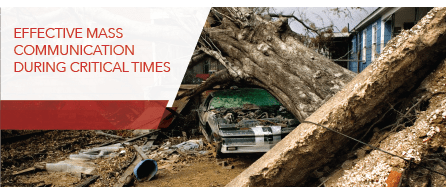
Behind the Effective Emergency Preparedness During Hurricane Matthew
During Hurricane Matthew people in the U.S. relied on cell phones to stay up to date with the hurricane’s path, as well as to receive critical messages from local authorities, the National Weather Service and the Federal Emergency Management Agency. Despite inevitable widespread destruction, emergency preparedness strategies were effective, evacuations ran smoothly and many properties, businesses and lives were saved. Effective mass emergency notification was at the heart of the success, before, during and after the storm. One of the most effective components in assuring people remained connected was mass text messaging
Despite the torrential rain and wind during the hurricane, most cell phone services in the U.S. were able to withstand the catastrophe. Large cell providers such as AT&T and Verizon had successfully prepared for the storm with back-up towers to maintain service, and some even offered free service for counties expected to be directly impacted by the storm.
Using SMS and social media to stay connected were among the recommended emergency preparedness strategies from FEMA to conserve the battery life of your phone and avoid overburdening the networks with high call volume. Text messages are also one of the ways that local, state and federal authorities can ensure that you receive critical messages with both local emergency alert systems and the Integrated Public Alert and Warning System (IPAWS). Officials use WEA (Wireless Emergency Alerts), a component of IPAWS, to guarantee the public receives alerts, because even if cell networks become overburdened and slow down, or stop temporarily, a message sent via Wireless Emergency Alert (part of IPAWS) will override the system and the message will still be sent. Florida successfully used IPAWS to send Wireless Emergency Alerts to the public during the hurricane.
WEA messages are short and to the point. Florida residents received messages like, “HURRICANE APPROACHING; SEEK SHELTER NOW! USE 911 FOR EMERGENCIES ONLY,” throughout the storm, when it was important for residents to take appropriate action to stay safe. IPAWS was also used to send messages via satellite and cable T.V., radio, and pre-recorded phone calls. In addition, residents were advised to download emergency alert apps to stay informed on the storm’s progression and what to do. The combination of tools allowed for the successful evacuation of thousands of people from Florida all the way up to North Carolina.
Luckily, governments, businesses, schools and communities are investing more and more in alert systems like Regroup, that include SMS messaging, apps with push notifications that can be used even when actual phone lines go down, automatic severe weather alerts from the National Oceanic and Atmospheric Administration and IPAWS to ensure connection with their intended audiences and keep people safe. Hurricane Matthew is a testimony to the success of these innovative, life-saving mass communication tools. Regroup’s unique cloud-based system is designed to withstand even the worst catastrophes and it even successfully withstood Hurricane Matthew. All customers hit by the hurricane sent hundreds of thousands of messages informing students, employees and the general public on what to do even during large-scale power-outages.
Categories
- Regroup Product Guides
- Disaster Recovery
- Employee Safety
- Routine Communications
- Mass Notification
- Critical Event Management
- Emergency Preparedness
- Corporate
- Insurance
- Business Continuity
- Business
- Education
- Uncategorized
- Nonprofit
- Healthcare
- Hospitality
- Government & Public Services
- Our Clients
- Awards
- COVID-19
- Safety & Preparedness
- Announcements